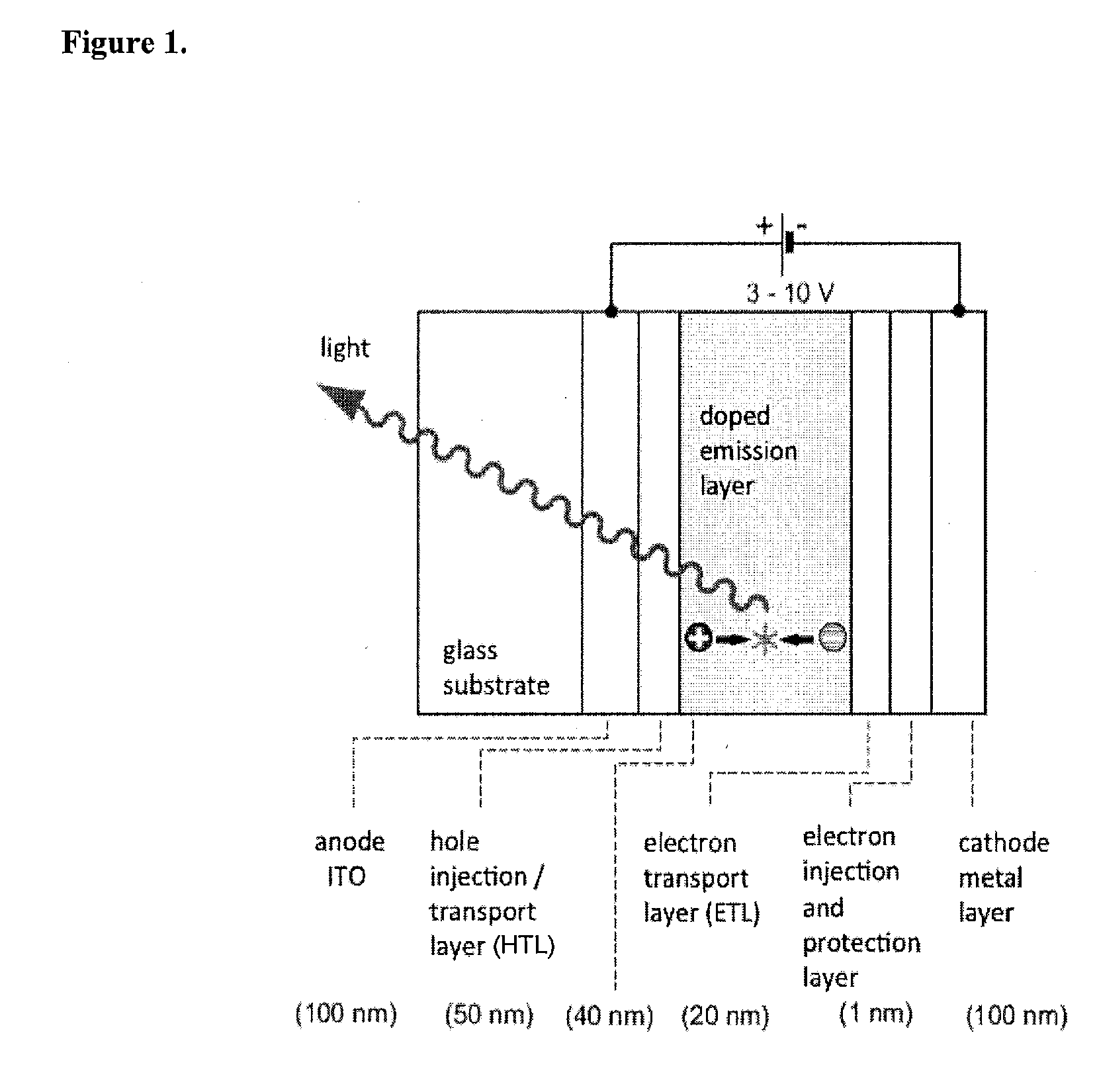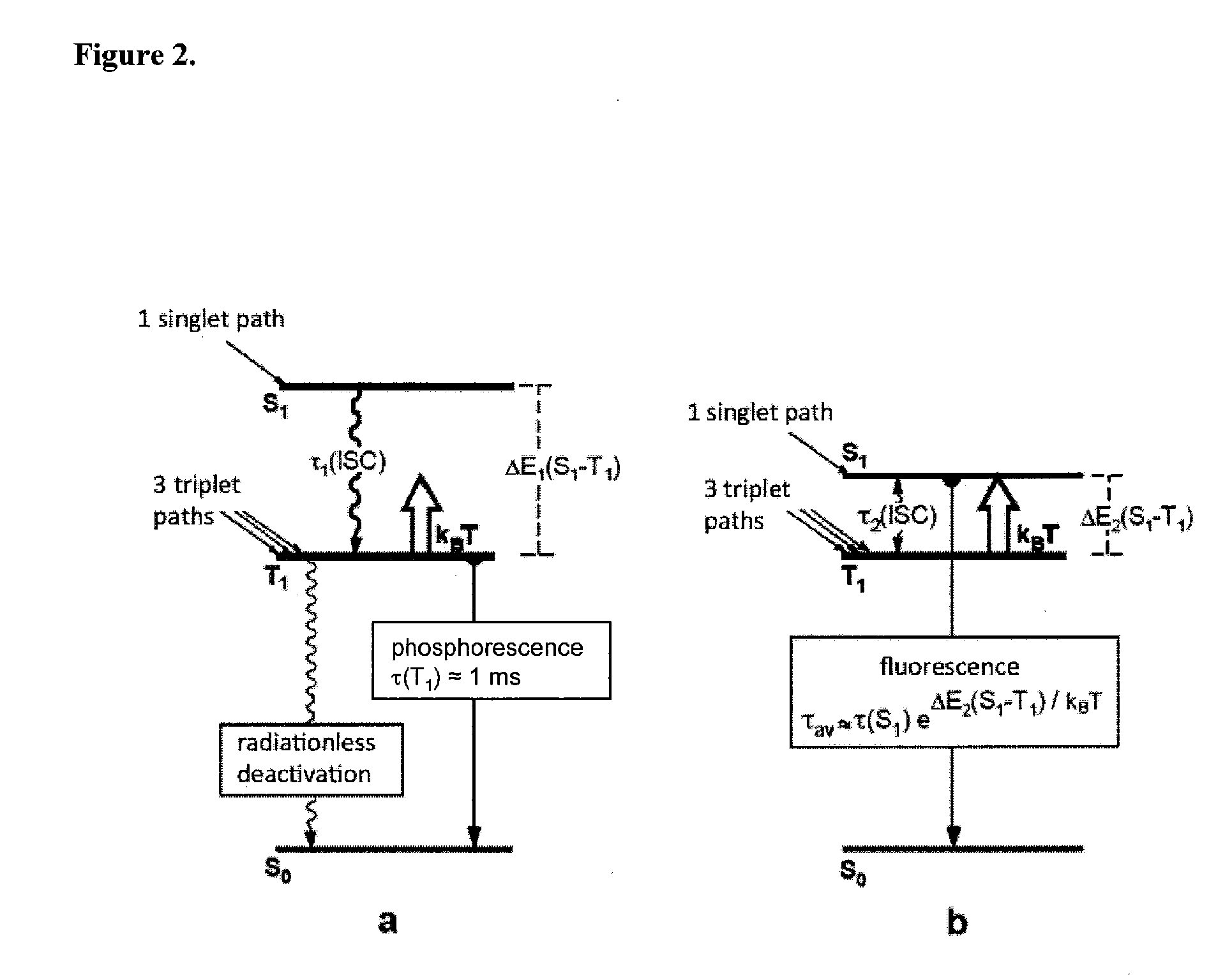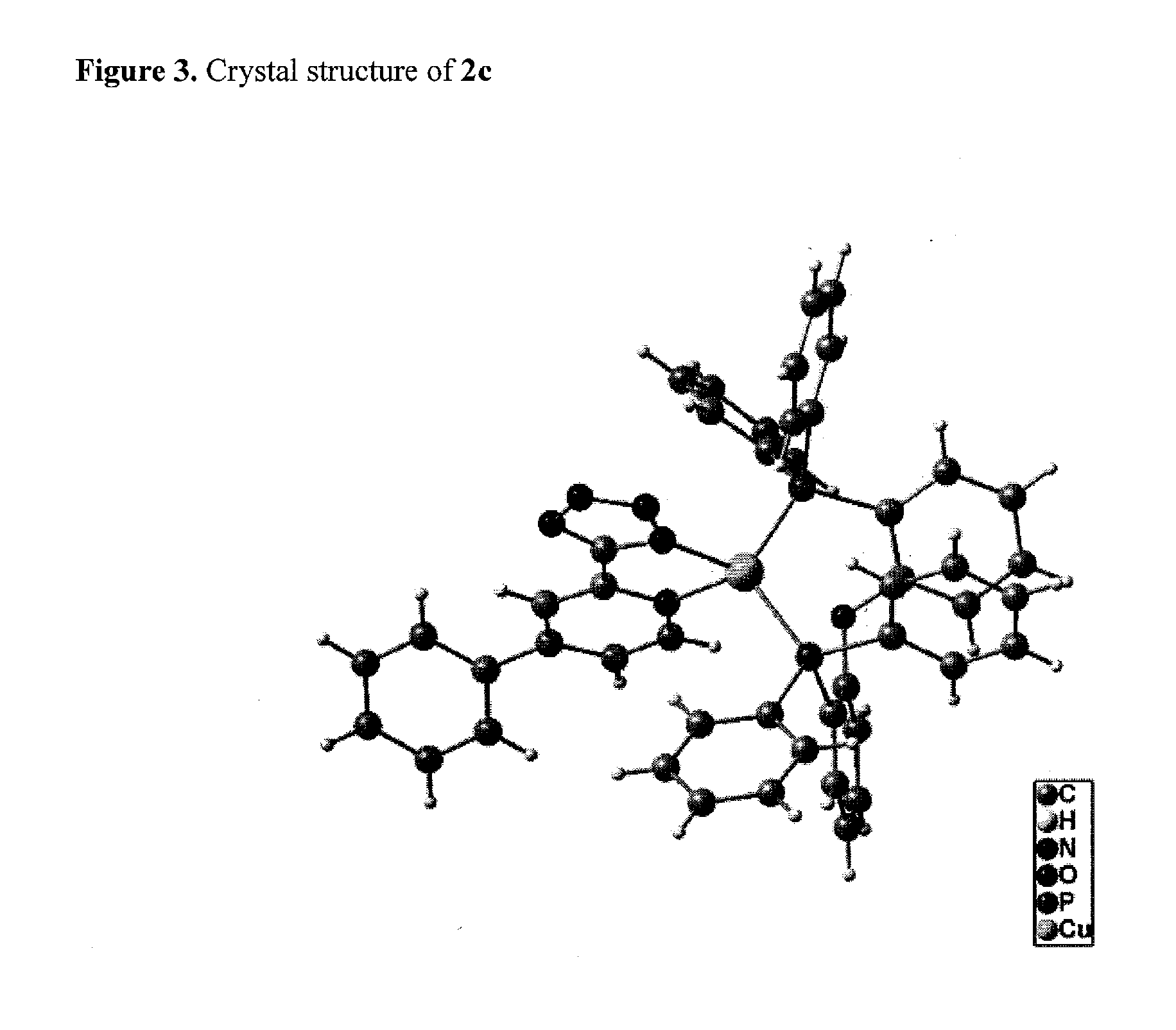Copper(i) complexes for optoelectronic devices
- Summary
- Abstract
- Description
- Claims
- Application Information
AI Technical Summary
Benefits of technology
Problems solved by technology
Method used
Image
Examples
example 1
[0107]The appropriate N∩L ligand (1.00 mmol, 1.00 eq.), [Cu(CH3CN)4]PF6 (10) (1.00 mmol, 1.00 eq.) and the L-B-L ligand (1.00 mmol, 1.00 eq.) were dissolved in 10 mL solvent mixture consisting of dichloromethane:ethanol=3:1 under nitrogen atmosphere and stirred for 4 h. The complex was purified by precipitation in diethyl ether, filtered, washed with diethyl ether and dried.
[0108]The complex obtained above (0.05 mmol, 1.00 eq.) and KOH (7.75 mmol, 15.0 eq.) were dissolved in 5 mL methanol under nitrogen atmosphere and stirred for 6 h. Subsequently, the solvent was removed in vacuo, the residue extracted with DCM and filtered. After removal of the solvent the complex was obtained as a white powder.
2c: L-B-L=Bis(diphenylphosphine)diphenylether:
Characterization:
[0109]Elemental analysis: C48H36CuN5OP2 (823.17): calc. C, 69.94; H, 4.40; N, 8.50.
[0110]found C, 69.41; H, 4.47; N, 8.00.
[0111]MS (FAB), m / z (%): 1423 (3) [LCu2(P̂P)2], 1139 (1) [Cu(P̂P)2], 888 (1) [LCu2P̂P], 860 (6) [LCu2P̂P—N...
example 2
[0137]The N∩L ligand (1.00 mmol, 1.00 eq.) was dissolved in 10 mL dichloromethane under nitrogen atmosphere, an equimolar amount of base added and stirred for 1 hour. Then an equimolar amount of Cu(CH3CN)4]BF4 was added, stirred for 1 hour, an equimolar amount of the appropriate L-B-L ligand added and stirred over night. The complex was purified by precipitation in diethyl ether, filtered, washed with diethyl ether and dried.
[0138]4a: L-B-L=2× PPh3:
[0139]Characterization:[0140]The emission lifetime of 4a is 0.8 μs (Horiba Fluoromax 4 with TCSPC).
[0141]4c: L-B-L=Bis(diphenylphosphine)diphenylether
[0142]Characterization:[0143]The emission spectrum of 4c at 298 K is shown in FIG. 9.[0144]The emission spectrum of 4c at 77 K is shown in FIG. 9.[0145]The emission quantum yield of 4c is 65% (measured with Hamamatsu C9920-02G).[0146]The emission lifetime of 4c is 1.0 μs (Horiba Fluoromax 4 with TCSPC).[0147]The ΔE(S1-T1) value of 4c is 169 cm−1 (determined by measuring the temperature depen...
example 3
[0151]The synthesis was carried out as mentioned in example 2.
[0152]6c: L-B-L=Bis(diphenylphosphin)diphenylether:
[0153]Characterization:
[0154]MS (FAB), m / z (%): 2195 (1) [L2Cu3(P̂P)3], 1917 (1) [L3Cu4(P̂P)2], 1660 (1) [L2Cu3(P̂P)2], 1400 (10) [LCu2(P̂P)2], 1140 (2) [Cu(P̂P)2], 860 (5) [LCu2(P̂P)], 798 (4) [LCuP̂P], 741 (6) [LCuP̂P—N4], 602 (100) [CuP̂P].[0155]The emission spectrum of 6c at 298 K is shown in FIG. 10.[0156]The emission quantum yield of 6c is 20% (measured with Hamamatsu C9920-02G).[0157]The emission lifetime of 6c is 0.7 μs (Horiba Fluoromax 4 with TCSPC).
[0158]6e: L-B-L=(Oxybis(3-methyl-6,1-phenylene))bis(diphenylphosphine):
[0159]Characterization:
[0160]MS (FAB), m / z (%): 2278 (1) [L4Cu6(P̂P)2—CH3], 1713 (2) [L2Cu3(P̂P)2], 1455 (12) [LCu2(P̂P)2], 1196 (1) [Cu(P̂P)2], 889 (7) [LCu2(P̂P)], 825 (2) [LCuP̂P], 769 (3) [LCuP̂P—N4], 739 (2) [LCuP̂P—N4—(CH3)2], 692 (2) [Cu2P̂P], 629 (100) [CuP̂P], L: tetrazole ligand, P̂P: phosphine ligand.
[0161]The emission spectrum of 6e at...
PUM
 Login to View More
Login to View More Abstract
Description
Claims
Application Information
 Login to View More
Login to View More - R&D
- Intellectual Property
- Life Sciences
- Materials
- Tech Scout
- Unparalleled Data Quality
- Higher Quality Content
- 60% Fewer Hallucinations
Browse by: Latest US Patents, China's latest patents, Technical Efficacy Thesaurus, Application Domain, Technology Topic, Popular Technical Reports.
© 2025 PatSnap. All rights reserved.Legal|Privacy policy|Modern Slavery Act Transparency Statement|Sitemap|About US| Contact US: help@patsnap.com



